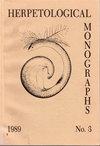新几内亚鳄鱼(新鳄鱼科)的颅骨形态测定学:颅骨相对生长的个体发生变异及其作为个体性别和大小预测因子的效用评估
IF 1.1
2区 生物学
Q3 ZOOLOGY
引用次数: 73
摘要
研究了新几内亚鳄(Crocodylus novaeguineae)的颅骨形态学,以量化颅骨相对生长的个体发生变异,为商业收获的种群提供可能的人口统计学见解。一般来说,增长属性是线性的,单变量统计提供了未转换值的大小估计。曲线大小(总长度)到年龄的转换是通过应用三种增长模型进行的:重新参数化的Richards曲线、von Bertalannfy模型和Brody曲线。只有通过Brody模型才能获得令人满意的性能,可靠的年龄估计仅限于较小的(<2米)个体。通过参数(多元判别分析- discrim)和非参数(二叉树分类分析- cart)方法评估相对生长比在正确预测已知性别动物性别方面的效用。创建交叉验证数据集以减少模型偏差并评估分类率的正确性。与DISCRIM模型相比,CART模型始终显示出更大的表观错误率与真实错误率的一致性,而每种方法的“最佳拟合”模型在提供从测量属性中正确区分性别的保守总体能力方面彼此密切平行。颅骨生长发生在三个不同的阶段,模仿跳跃的个体发生反应,并被假设与功能性觅食反应有关。本文章由计算机程序翻译,如有差异,请以英文原文为准。
Cranial Morphometry of New Guinea Crocodiles (Crocodylus novaeguineae): Ontogenetic Variation in Relative Growth of the Skull and an Assessment of Its Utility as a Predictor of the Sex and Size of Individuals
The cranial morphometry of New Guinea crocodiles (Crocodylus novaeguineae) was investigated to quantify ontogenetic variation in relative growth of the skull to provide possible demographic insights into commercially harvested populations. Growth attributes were, in general, linear, and univariate statistics provided estimates of size from untransformed values. Curvilinear size (total length) to age transformations were attempted through applications of three growth models: a reparameterized Richards curve, the von Bertalannfy model, and a Brody curve. Satisfactory performance was attained only through the Brody model, with reliable age estimates restricted to smaller (<2 m) individuals. The utility of relative growth ratios to correctly predict the sex of known gender animals was assessed by both parametric (multivariate discriminant analysis-DISCRIM) and nonparametric (binary tree classification analysis-CART) methods. Crossvalidation data sets were created to reduce model biases and to evaluate the correctness of classification rates. CART models consistently showed greater congruence of apparent error rates with true error rates than did DISCRIM models, while the 'best fit' models of each method closely paralleled one another in providing conservative overall ability to correctly discriminate gender from measured attributes. Skull growth occurs in three distinctive stages that mimic a saltatory ontogenetic response and are hypothesized to be related to functional foraging responses.
求助全文
通过发布文献求助,成功后即可免费获取论文全文。
去求助
来源期刊

Herpetological Monographs
生物-动物学
CiteScore
5.40
自引率
0.00%
发文量
2
审稿时长
>12 weeks
期刊介绍:
Since 1982, Herpetological Monographs has been dedicated to original research about the biology, diversity, systematics and evolution of amphibians and reptiles. Herpetological Monographs is published annually as a supplement to Herpetologica and contains long research papers, manuscripts and special symposia that synthesize the latest scientific discoveries.
 求助内容:
求助内容: 应助结果提醒方式:
应助结果提醒方式:


